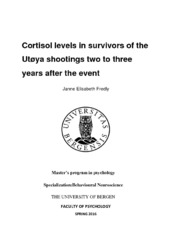Cortisol levels in survivors of the Utøya shootings two to three years after the event
Master thesis
Permanent lenke
https://hdl.handle.net/1956/12203Utgivelsesdato
2016-05-18Metadata
Vis full innførselSamlinger
Sammendrag
Survivors of the Utøya shootings 2011 are at risk at developing PTSD/PTSS symptoms. Previous research has addressed the biological markers associated with the development of PTSD/PTSS, with special attention to the HPA axis, and the hormones secreted. In the present study, we try to identify some of these biological markers (cortisol) and discuss possible explanations to the observed changes. The survivors of the Utøya shootings were further subdivided into those with PTSD/PTSS symptoms and those who did not compared to a non-exposed control group. Salivary cortisol was collected by home assessments, and before and after a fMRI scanning sequence The sampling occurred over a three day period to assess a normal circadian cortisol rhythm, and particularly the cortisol awakening response was of interest. This phenomenon occurs right after awakening. Approximately 15 to 30 minutes after awakening the cortisol levels increase. The Utøya subjects with PTSD/PTSS showed a lower overall cortisol output than the two other groups, especially with respect to the cortisol increase (AUCi). The results provide evidence of alterations in the HPA axis in the subjects who developed PTSD/PTSS after the Utøya shootings, and provide increased understanding of some of the biological markers of PTSD. Key words: Cortisol, HPA-axis, cortisol awakening response, Posttraumatic stress disorder, trauma Overlevende etter Utøyamassakren i 2011 står i fare for å utvikle symptomer på PTDD/PTSS. Tidligere forskning har befattet seg med de biologiske markørene som assosieres med utvikling av PTSD/PTSS, og med særskilt oppmerksomhet rettet mot HPA-aksen og hormonene som utskilles. I den foreliggende studien førsøker vi å identifisere noen av de biologiske markørene (kortisol) for så å drøfte mulige forklaringer på de forandringene som er blitt observert. Overlevende fra Utøya ble ytterlige delt inn i undergrupper: De som utviste PTSD/PTSS- symptomer, og de som ikke gjorde det, sammenlignet med en ikke utsatt kontrollgruppe. Kortisol fra spytt ble samlet inn ved spytteprøver hjemme, og før og etter en fMRI- scanning. Prøvetakingen foregikk over en tredagers periode for å kunne vurdere en normal døgnrytme med henhold til kortisol, og av særskilt interesse var da kortisolets oppvåkningsrespons. Dette inntreffer like etter oppvåkning. Omtr. 15 til 30 minutter etter oppvåkning øker kortisolnivåene. Utøyaoverlevende med PTSD/PTSS viste en lavere gjennomsnitt kortisolproduksjon enn de to andre gruppene, særlig med hensyn til kortisolstigning (AUCi). Resultatene som foreligger viser tegn på endringer i HPA-aksen hos personer som utviklet PTSD/PTSS etter Utøya-skytingen og bringer økt forståelse av noen av de biologiske markørene vedrørende PTSD. Nøkkelbegreper: Kortisol, HPA-aksen, kortisolets oppvåkningsrespons, posttraumatisk stresslidelse, traume.
